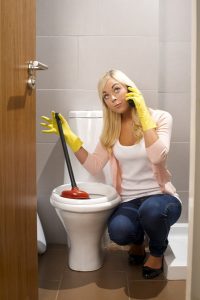It is almost inevitable that you will have to deal with a plugged drain somewhere in your home at some point. This drain may be in the bathtub, a sink or a toilet. But wherever it is, a plunger is usually your best bet for getting it out. If you are going to be successful, though, you need to know how to set yourself up and use the plunger properly.
To begin with, remove the strainer or pop-up plug from the opening of the drain. You want the material that is clogging the drain to be able to come back up through that hole when you apply the plunger suction. Next, make sure the sink or tub has enough water in it to cover the head of the plunger completely. A toilet generally has enough water in it already. This water helps to create a better seal for the plunger and allows you to generate better suction, both of which are essential if you are going to dislodge that plug.
You should also make sure you block off any other outlet connected to the drain you are going to plunge. To do this, stuff an old rag or sponge into the overflow opening or into the second drain of a two compartment sink. That will make it possible for the entire force of your suctioning to reach the clog because it will not be compromised by air escaping through an alternate opening.
Now you are ready to plunge. Place the plunger over the opening of the clogged drain. While keeping constant contact with the sink or tub floor, move the plunger rapidly up and down between 10 and 20 times. After the last plunge, pull the plunger off of the sink or tub floor quickly. This should break the seal you have established and help to pull the clog back up the drain towards you.
It can take a few cycles like this before you are able to dislodge the clog completely. But each time you plunge, you are doing more to break up the clog. The pressure from the plunger can eventually get rid of many difficult clogs, so do not be discouraged if it takes a few tries.
Continue Reading
Tags: Clogged Drains, Corona Del Mar, Fountain Valley, Fullerton
Posted in Services | Comments Off on How to Plunge a Clogged Drain
 Drain clogs are just about as common a problem as can affect the plumbing in a home. The usual culprits for clogged or slow drains are hair clogs, FOG (fats, oils, and grease), hard water minerals, soap scum, food, and more serious problems with the sewer line. If you can’t clear out a clog using a plunger or a basic hand-cranked drain snake, then it’s recommended you call for a plumber in San Juan Capistrano, CA who’s licensed and equipped to take care of the problem.
Drain clogs are just about as common a problem as can affect the plumbing in a home. The usual culprits for clogged or slow drains are hair clogs, FOG (fats, oils, and grease), hard water minerals, soap scum, food, and more serious problems with the sewer line. If you can’t clear out a clog using a plunger or a basic hand-cranked drain snake, then it’s recommended you call for a plumber in San Juan Capistrano, CA who’s licensed and equipped to take care of the problem.